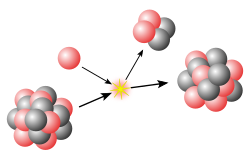| Nuclear physics |
|---|
 |
Photofission is a process in which a nucleus, after absorbing a gamma ray, undergoes nuclear fission and splits into two or more fragments.
The reaction was discovered in 1940 by a small team of engineers and scientists operating the Westinghouse Atom Smasher at the company's Research Laboratories in Forest Hills, Pennsylvania. [1] They used a 5 MeV proton beam to bombard fluorine and generate high-energy photons, which then irradiated samples of uranium and thorium. [2]
Gamma radiation of modest energies, in the low tens of MeV, can induce fission in traditionally fissile elements such as the actinides thorium, uranium, [3] plutonium, and neptunium. [4] Experiments have been conducted with much higher energy gamma rays, finding that the photofission cross section varies little within ranges in the low GeV range. [5]
Baldwin et al. made measurements of the yields of photo-fission in uranium and thorium together with a search for photo-fission in other heavy elements, using continuous x-rays from a 100-MeV betatron. Fission was detected in the presence of an intense background of x-rays by a differential ionization chamber and linear amplifier, the substance investigated being coated on an electrode of one chamber. They deduced the maximum cross section being of the order of 5×10−26 cm2 for uranium and half that for thorium. In the other elements studied, the cross section must be below 10−29 cm2. [6]